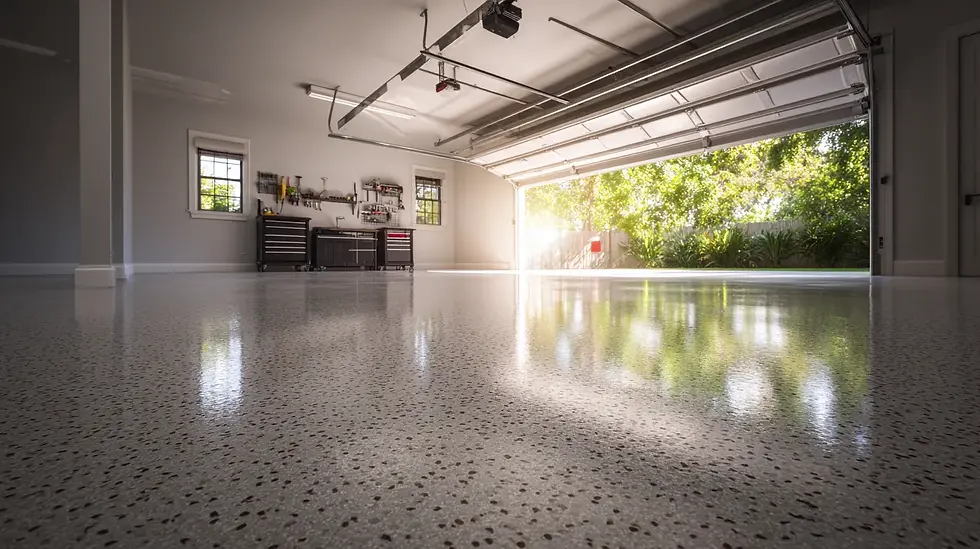Why Some Garage Coatings Fail in Texas Heat & How to Prevent It?
- Ava Reynolds

- Nov 12
- 3 min read
You already know that Texas heat is a serious problem if you live here. It's easy for summer temperatures to rise above 100°F, and that kind of extreme heat affects not only you but also your house, particularly your garage floor.
You may have spent money on a garage floor coating to improve the appearance, durability, and cleanliness of your area. However, what occurs if, within a year or two, that coating begins to peel, bubble, or fade? Regretfully, homeowners in the Lone Star State frequently deal with this problem.
Let's find out why certain garage coatings degrade in Texas heat and, more crucially, how to keep your own floor from experiencing this.

Why Garage Floor Coatings Fail Under Texas Heat?
Garage floor coatings are designed to protect concrete, but not all coatings are created equal. The unique weather patterns in Texas—high UV exposure, sudden temperature swings, and humidity—put a lot of stress on concrete surfaces. Here’s what typically causes failure:
Using the Wrong Type of Coating
Many homeowners choose basic epoxy because it’s affordable and widely available. While epoxy can look good initially, it doesn’t hold up well under extreme heat. It softens when temperatures rise, making it prone to bubbling, peeling, or yellowing over time.
In contrast, polyaspartic or polyurethane coatings are far more heat-resistant. They can withstand Texas summers without fading or cracking, which makes them a better long-term investment.
Poor Surface Preparation
Before any garage floor coating in DFW is applied, the concrete must be properly cleaned and etched. This allows the coating to bond securely to the surface.
Skipping or rushing this step leads to weak adhesion, which means your coating might start flaking within months—especially when exposed to heat that causes expansion and contraction.
Moisture and Humidity
Even in hot weather, humidity remains a silent culprit. When moisture is trapped under a coating, it expands as the temperature rises, leading to blisters or bubbles.
Professional installers often use moisture mitigation systems to test and treat concrete before coating, ensuring it can handle Texas humidity without issues.
UV Exposure
Direct sunlight can cause coatings to yellow or chalk over time. This is particularly true for cheaper epoxies or single-layer coatings. The best way to combat this is by using UV-stable topcoats—something high-quality polyaspartic coatings excel at.
Improper Installation Timing
Applying a coating in the middle of a scorching summer afternoon can cause it to cure too quickly, creating a weak surface layer. Professionals usually apply coatings early in the morning or in climate-controlled garages to achieve a smooth, even cure.
How to Prevent Garage Coatings from Failing in Texas Heat?
Now that we know why coatings fail, let’s talk about how to make them last—because with the right approach, your garage floor coating can easily stay flawless for over a decade.
Choose the Best Concrete Coating for Garage Floors
If you’re in Texas, skip traditional epoxy. Instead, go for polyaspartic coatings or polyurea systems. These materials are built to handle the heat. They’re UV-stable, fast-curing, and flexible enough to expand and contract with temperature changes—without cracking.
These coatings also resist chemicals, oil stains, and tire marks—ideal for busy garages.
Ensure Professional Surface Preparation
A beautiful coating starts with good prep work. The concrete should be ground down with diamond tools and moisture-tested before the first layer goes on. Professional installers know exactly how to prep concrete for maximum adhesion and longevity.
Add a UV-Protective Topcoat
A UV-resistant topcoat acts like sunscreen for your garage floor. It prevents fading, yellowing, and surface breakdown, keeping your coating looking brand-new even after years of sun exposure.
Maintain Proper Ventilation
If your garage traps heat, consider adding vents or using reflective window films. Excessive heat buildup accelerates wear and tear on the coating surface. Keeping airflow steady helps maintain temperature balance and coating health.
Monitor the Installation Temperature
Timing matters. Applying coating at cooler times of day allows for better curing and bonding. Expert installers schedule applications based on both ambient and concrete surface temperatures to ensure optimal performance.
The Smart Way to Beat the Texas Heat
Your garage floor doesn’t have to fall victim to the Texas sun. The secret lies in choosing the right materials, preparing the surface properly, and trusting experienced installers who understand the unique local climate.
Whether you want a sleek showroom finish or a heavy-duty surface for everyday use, a properly applied garage floor coating can handle it all—heat, humidity, and heavy wear.
For homeowners across Texas looking for durability and beauty that lasts, American Concrete Coatings delivers top-tier results. Their expert team knows exactly how to prep, coat, and protect your concrete for long-lasting performance in even the toughest Texas conditions.





Comments